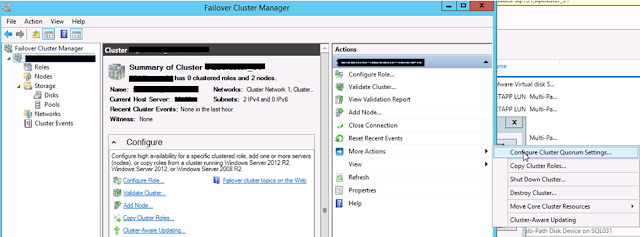Hi Guys,
As we have seen my previous posts on how to configure the Windows Clustering and Setup the Quorum, now we will move forwards towards the final step to configure the SQL Server Cluster.
Installing and Configuring SQL Server Cluster is very much similar to installing a SQL Stand alone Server. Here, we will install and configure a two node Active - Passive Cluster and will see only the different pages occur while Installing and Configuring the SQL Server Clustering rest pages remains the same.
Let's start with the installation of SQL Server Cluster on Active Server. Following are snapshots for it:
1. Start the installation and Click "Installation" link on left hand side of the page. And then start the installation with "New SQL Server Failover Cluster Installation".
2. After couple of Next and Next's you will land to "Instance Configuration" page. Now here you have to Enter the "SQL Server Network Name" and the "Instance Name" (For named instance)
For Eg. If you enter here the Network Name as "SQLServer_01" and Instance Name as "SQL01". Then the Server Name in the connectivity will be "SQLServer_01\SQL01".
3. Again after few Next's you will land to "Cluster Resource Group" page, were you have to enter a Unique name as a Cluster Resource Group Name. This will help in case there are multiple Cluster configuration.
4. Here we have to check all the Disks which you want to bring under that Cluster Group.
5. Enter an "Unique IP address" in the Address box after un-checking the DHCP.
6. So by now your SQL Server Cluster is installed on the Active Node. Now, you have to start Adding node on the Passive instance. As you can see the snapshot you have to start the installation and Click "Installation" link on left hand side of the page. But this time choosing "Add node to a SQL Server Failover Cluster".
Rest of the process are simple. So now the SQL Server Cluster is ready to deploy your Database.
Click here to refer Part 1 and Part 2 of this topic.
We will discuss the Errors while configuring the SQL Server Clustering in different post. So stay tuned.
Till then Keep Learning and Enjoy Learning!!!
As we have seen my previous posts on how to configure the Windows Clustering and Setup the Quorum, now we will move forwards towards the final step to configure the SQL Server Cluster.
Installing and Configuring SQL Server Cluster is very much similar to installing a SQL Stand alone Server. Here, we will install and configure a two node Active - Passive Cluster and will see only the different pages occur while Installing and Configuring the SQL Server Clustering rest pages remains the same.
Let's start with the installation of SQL Server Cluster on Active Server. Following are snapshots for it:
1. Start the installation and Click "Installation" link on left hand side of the page. And then start the installation with "New SQL Server Failover Cluster Installation".
2. After couple of Next and Next's you will land to "Instance Configuration" page. Now here you have to Enter the "SQL Server Network Name" and the "Instance Name" (For named instance)
For Eg. If you enter here the Network Name as "SQLServer_01" and Instance Name as "SQL01". Then the Server Name in the connectivity will be "SQLServer_01\SQL01".
3. Again after few Next's you will land to "Cluster Resource Group" page, were you have to enter a Unique name as a Cluster Resource Group Name. This will help in case there are multiple Cluster configuration.
4. Here we have to check all the Disks which you want to bring under that Cluster Group.
5. Enter an "Unique IP address" in the Address box after un-checking the DHCP.
6. So by now your SQL Server Cluster is installed on the Active Node. Now, you have to start Adding node on the Passive instance. As you can see the snapshot you have to start the installation and Click "Installation" link on left hand side of the page. But this time choosing "Add node to a SQL Server Failover Cluster".
Rest of the process are simple. So now the SQL Server Cluster is ready to deploy your Database.
Click here to refer Part 1 and Part 2 of this topic.
We will discuss the Errors while configuring the SQL Server Clustering in different post. So stay tuned.
Till then Keep Learning and Enjoy Learning!!!











